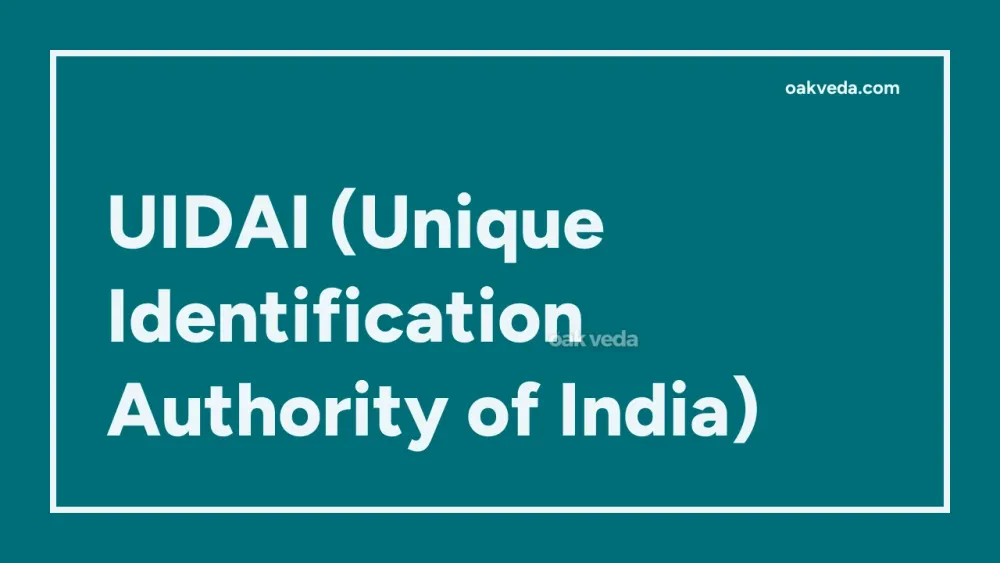
What is the Full Form of UIDAI?
UIDAI is the full form of Unique Identification Authority of India. This government agency plays a crucial role in India's digital identity ecosystem and is responsible for implementing the Aadhaar program, which aims to provide a unique identification number to all Indian residents.
What is Unique Identification Authority of India?
The Unique Identification Authority of India (UIDAI) is a statutory authority established by the Government of India under the provisions of the Aadhaar Act 2016. It operates under the Ministry of Electronics and Information Technology (MeitY) and is tasked with issuing Aadhaar numbers, a 12-digit unique identifier, to all residents of India.
Origin and Development of UIDAI
UIDAI's journey began in January 2009 when it was initially set up as an attached office under the Planning Commission. The primary objective was to develop and implement the necessary institutional, technical, and legal infrastructure to issue unique identity numbers to Indian residents.
Key milestones in UIDAI's development include:
- 2010: Launch of the Aadhaar project
- 2016: Enactment of the Aadhaar Act, providing statutory status to UIDAI
- 2017: Expansion of Aadhaar's use in various government and private sector services
How does UIDAI work?
UIDAI operates through a network of enrolling agencies and registrars across India. The process involves:
- Data Collection: Gathering demographic and biometric information from residents
- De-duplication: Ensuring uniqueness by comparing collected data with existing records
- Aadhaar Generation: Issuing a 12-digit Aadhaar number to the individual
- Authentication: Providing a platform for identity verification using Aadhaar
Functions of UIDAI
The primary functions of UIDAI include:
- Issuing Aadhaar numbers to residents
- Developing policies and procedures for Aadhaar enrollment and authentication
- Ensuring the security and confidentiality of identity information
- Maintaining and updating resident information in the Central Identities Data Repository (CIDR)
- Specifying usage and applicability of Aadhaar for various services
Applications of UIDAI
UIDAI's Aadhaar system has found widespread applications in:
- Government Subsidies: Direct Benefit Transfer (DBT) for various welfare schemes
- Financial Inclusion: Opening bank accounts and accessing financial services
- Taxation: Linking Aadhaar with PAN for income tax purposes
- Telecom: e-KYC for mobile SIM card issuance
- Education: Student identification and scholarship disbursement
Features of UIDAI
Some key features of UIDAI include:
- Biometric-based Identification: Using fingerprints and iris scans for unique identification
- Scalable Architecture: Capable of handling large-scale enrollment and authentication requests
- Open API Platform: Allowing integration with various services and applications
- Multi-modal Authentication: Offering different methods of identity verification
- Data Security: Implementing robust measures to protect sensitive information
Benefits of UIDAI
The implementation of UIDAI and Aadhaar has brought several benefits:
- Improved Governance: Enhancing transparency and efficiency in public service delivery
- Financial Inclusion: Enabling easier access to banking and financial services
- Reduced Fraud: Minimizing duplicate and fake identities in welfare schemes
- Digital Identity: Providing a universal, easily verifiable ID for residents
- Cost Savings: Streamlining government processes and reducing leakages in subsidy distribution
Limitations or Challenges of UIDAI
Despite its advantages, UIDAI faces several challenges:
- Privacy Concerns: Debates over data protection and potential misuse of personal information
- Exclusion Issues: Instances of denial of services due to Aadhaar-related problems
- Technical Glitches: Occasional system failures affecting authentication processes
- Legal Challenges: Ongoing court cases regarding the constitutionality and scope of Aadhaar
- Cybersecurity Risks: Potential vulnerabilities in the vast database of sensitive information
Future Developments in UIDAI Technology
UIDAI continues to evolve, with several future developments on the horizon:
- Enhanced Security Measures: Implementing advanced encryption and data protection techniques
- Artificial Intelligence Integration: Using AI for improved fraud detection and system efficiency
- Blockchain Technology: Exploring blockchain for secure and transparent identity management
- International Collaboration: Potential partnerships for cross-border identity verification
- Expansion of Services: Integrating Aadhaar with more government and private sector applications
FAQs on UIDAI Full Form
-
What is the main purpose of UIDAI? UIDAI's primary purpose is to issue unique Aadhaar numbers to all Indian residents and provide a reliable, digital means of identity verification.
-
Is Aadhaar mandatory for all Indian citizens? While Aadhaar is not mandatory for all services, it is required for accessing many government benefits and services.
-
How does UIDAI ensure data privacy? UIDAI implements strict security protocols, encryption techniques, and access controls to protect the privacy of Aadhaar holders' information.
-
Can non-residents of India obtain an Aadhaar number? Aadhaar is primarily for residents of India. Non-resident Indians (NRIs) can obtain Aadhaar if they reside in India for 182 days or more in the 12 months preceding the date of application.
-
How can I update my Aadhaar information? You can update your Aadhaar information online through the UIDAI website or by visiting an Aadhaar Seva Kendra.
In conclusion, UIDAI plays a vital role in India's digital infrastructure, providing a unique identification system that has transformed various aspects of governance and service delivery. As technology evolves, UIDAI continues to adapt and improve its systems to meet the changing needs of India's diverse population.
You may be interested in:
- EJB (Enterprise JavaBeans): Full Form and Guide
- HSBC (Full Form): Hong Kong and Shanghai Banking Corporation
- COB (Close of Business): Full Form and Meaning
- KPO (Knowledge Process Outsourcing) Full Form
- RFID (Radio Frequency Identification) Full Form
- CUB (City Union Bank Limited): Full Form and Overview

